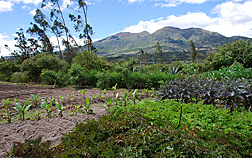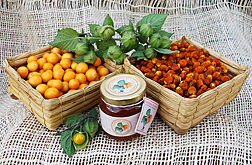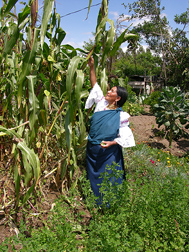Conserving Crop Diversity
and a Way of Life in Ecuador
|
|
Can conservation of traditional crops, in an area considered one of the cradles of world agriculture, contribute to the livelihoods of the local people? An ARS researcher is working with an international team of scientists to do just that in rural indigenous communities in Ecuador.
For thousands of years, in the northern Andean highlands of Ecuador, people in the Quichua-speaking communities surrounding the town of Cotacachi have cultivated crops across a wide range of elevations, climates, and soils. The result is a microcenter of agricultural diversity, a region where fields and gardens offer 30 varieties of corn, 40 varieties of beans, and a stunning diversity of chile peppers, squashes, potatoes, cape gooseberries, passion fruits, and other crops little known outside the Andes.
As in many rural areas, life in Cotacachi is changing. Many families now depend on income earned elsewhere, and men, in particular, often work away from family farms.
The changes have prompted concerns among local people that the traditional way of life in Cotacachi, along with many of the indigenous crops, may be lost. At stake are crop varieties that are the basis of local food security and culture as well as a rich source of genes for plant breeding programs, says Karen A. Williams, a botanist in the Plant Exchange Office of the ARS National Germplasm Resources Laboratory in Beltsville, Maryland. Williams has been working in Ecuador periodically since 1995, when she went there to help reestablish Ecuador’s national peanut germplasm collection, fill gaps in the USDA collection of peanut germplasm, and strengthen U.S.-Ecuadorian collaborations in genetic resources.
Partnering with an indigenous community organization, the Union of Indigenous and Peasant Communities (UNORCAC); Bioversity International, an international organization with a mandate to advance conservation and use of genetic diversity worldwide; and the Ecuadorian National Agricultural Research Institute (INIAP), ARS’s equivalent in Ecuador, Williams helped set up and now advises a program designed to promote conservation and increase use of local crops in the area. The Cotacachi project was in large part responsible for UNORCAC being awarded the Equator Prize from the United Nations Development Program in 2008 in recognition of efforts to conserve agricultural biodiversity.
|
|
The project, funded mainly by the USDA Foreign Agricultural Service, involves several innovative approaches designed to add value to indigenous crop varieties by promoting alternative uses, raising local awareness about the value of the indigenous crops, and increasing the availability of local varieties to farmers.
Efforts began in 2002 with a survey of more than 300 farm families on the crop varieties grown and their specific characteristics. Scientists at Ecuador’s National Department of Plant Genetic Resources (INIAP-DENAREF) have saved samples of much of this genetic treasure trove in the National Germplasm Bank at the INIAP Santa Catalina Experiment Station near Quito. Farmers worked with the scientists to evaluate the local varieties in a community garden in Cotacachi, and a catalog was produced to document the vastness of the diversity. Seed fairs have been held so that farmers could display and exchange crop varieties and recoup some varieties they had lost.
The project included construction of a food-processing plant to develop and package salsas, marmalades, and other products made from local crops. The products—sold in area hotels, small grocery stores, and delicatessens—include Andean blackberry marmalade, spicy pepper paste, dried cape gooseberries, and roasted black squash seeds. Farmer cooperatives, organized and trained through the project, provide the produce for the processing plant.
A community-run ethnobotanical garden, established as part of the project, supplies midwives with medicinal plants, serves as an educational resource for schoolchildren, and generates income, enabling visitors to see the diversity of local Andean plants in exchange for small donations.
Students at the local bilingual (Quichua-Spanish) schools learn about their agricultural heritage and the importance of using and conserving traditional crops, following a guide developed in cooperation with teachers.
Promoting Agrotourism
A major part of the effort is focused on developing offerings for tourists based on local culinary traditions and the crops that inspired them. Cotacachi is near the popular tourist destinations of the Cotacachi-Cayapas Nature Reserve, with its stunning volcanic lagoon, and the town of Otavalo, home to a world-renowned handicrafts market.
The project has provided financing for construction of three rustic rural lodges that, along with a dozen previously built lodges, are owned by local families who offer rooms to visitors. The lodges are adjacent to the homes of the families, who prepare meals made with vegetables, fruits, tubers, and grains from dooryard gardens that have been expanded with additional crop varieties. Visitors learn about traditional crops and farm practices, and the income they provide to farm families is an incentive for continuing crop conservation.
Tourists can also attend agriculturally related festivals, such as Inti Raymi, the Festival of the Sun, which is held at harvest time every year.
At the ethnobotanical garden, tourists learn about the diversity of crop and medicinal plants grown in nearby communities. The garden is in full view of the spectacular Cotacachi and Imbabura volcanoes, and its design is compatible with the cultural views of the local people.
The Role of Women
During the 6 years of the project, organizers have worked with 3,000 Ecuadorian farm families from dozens of communities. But much of the work has focused on the women of Cotacachi, who play a fundamental role in Andean agriculture. Revitalization of home gardens has provided women with a greater diversity of crops—essential to feeding their own families and to providing surpluses that can be sold at the town market.
Workshops on nutrition and traditional cooking reinforced use of native crops with younger housewives. A book of traditional recipes was compiled to revitalize the heritage of foods in the region.
Women have formed cooperatives that use the crops to produce a variety of items sold to tourists. They use native variegated lima beans called “tortas” to make handcrafted necklaces and bracelets and fiber from the cabuyo plant—a relative of agave—to make traditional sandals and decorative weavings with crop motifs.
“Women’s vital contributions to food security and income generation in the communities of Cotacachi have been recognized and enhanced as a result of this project,” says Williams.—By Dennis O'Brien, Agricultural Research Service Information Staff.
The research is part of Plant Genetic Resources, Genomics, and Genetic Improvement, an ARS national program (#301) described on the World Wide Web at www.nps.ars.usda.gov.
Karen A. Williams is with the USDA-ARS Plant Exchange Office, National Germplasm Resources Laboratory, 10300 Baltimore Ave., Beltsville, MD 20705-2350; phone (301) 504-5421, fax (301) 504-6305.
"Conserving Crop Diversity and a Way of Life in Ecuador" was published in the August 2009 issue of Agricultural Research magazine.









